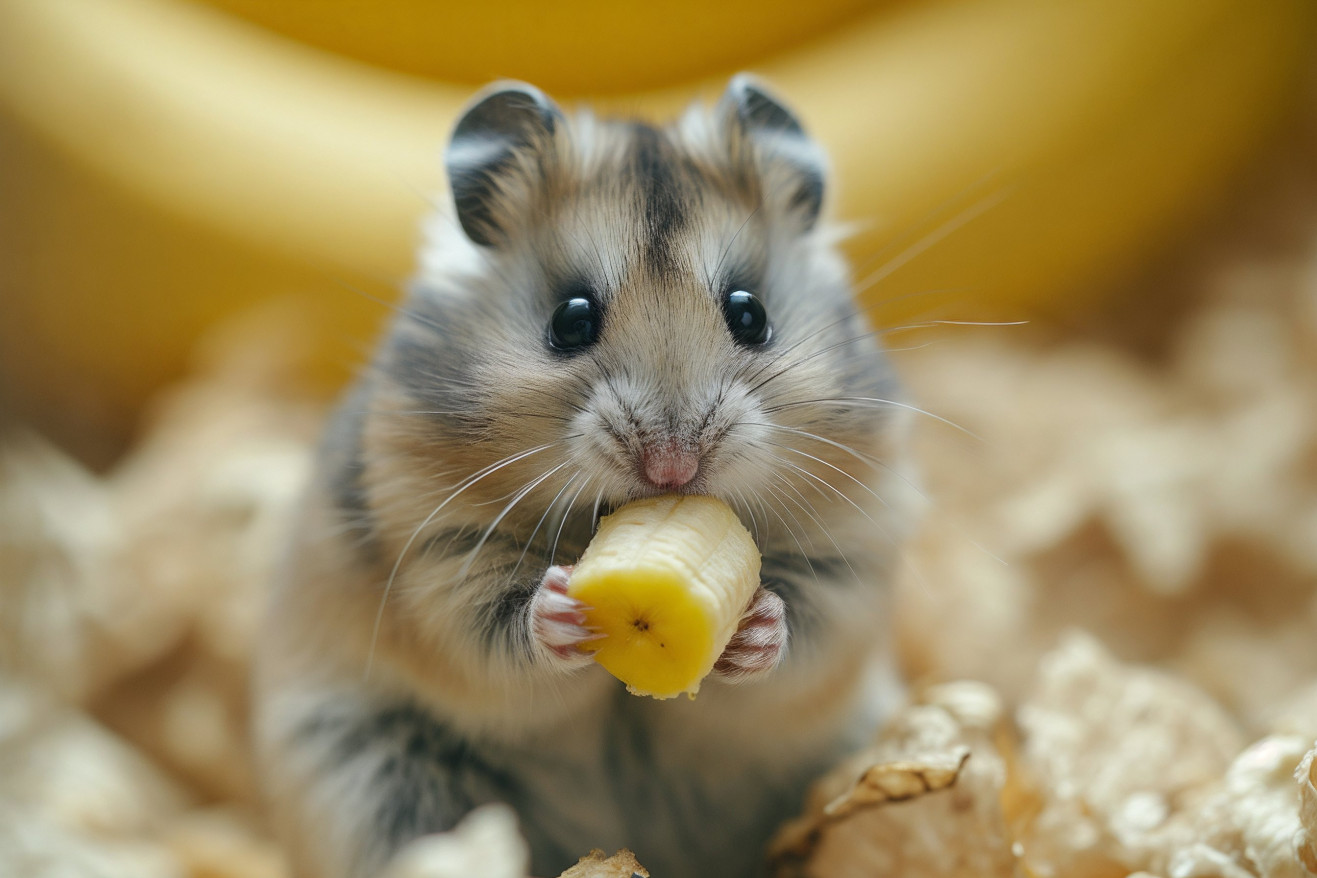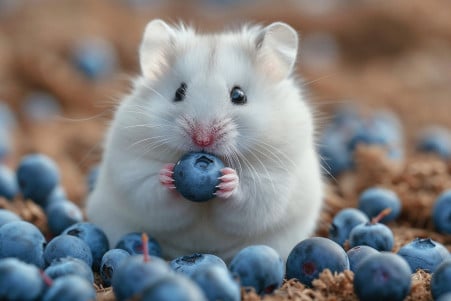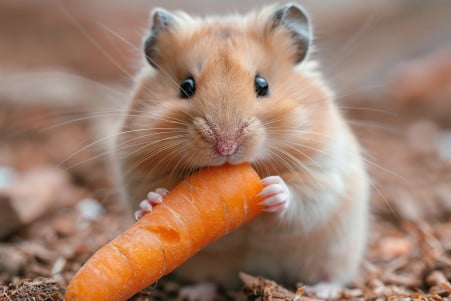Can Hamsters Eat Bananas? What You Need to Know
2 February 2024

Bananas are a tasty snack, but can you share them with your pet hamster? Hamsters can have bananas as long as they are given in moderation because they are high in sugar.
You can give your hamster a few small pieces, which is about 1–2 tablespoons, once or twice a week. If you have a dwarf hamster, you may want to limit or avoid giving them bananas altogether since they are more likely to develop diabetes. Make sure to introduce bananas to your hamster slowly.
This article takes a deep dive into veterinary opinions and nutritional facts to help you better understand how bananas can fit into your hamster’s diet. It also looks at studies by animal nutritionists and research on the digestive systems of small mammals, with a special focus on hamsters’ specific metabolic requirements.
You’ll also find out how to make sure that treats like bananas are in balance with your hamster’s staple diet so that you can keep your furry friend healthy and happy, minus the scientific jargon.
Can hamsters have bananas?
How Bananas Fit into a Hamster’s Diet
As a nutrient-rich food, bananas have several effects on a hamster’s well-being. According to a Healthline article, a medium banana has approximately 112 calories, 29 grams of carbs, 3 grams of fiber, and a number of important vitamins and minerals, including potassium, vitamin B6, and vitamin C.
For hamsters, the sugar and fiber content of bananas is most important. Ripe bananas can be high in sugar, including fructose, glucose, and sucrose, which can account for more than 16% of their weight.
This is especially important for hamster owners, especially those with dwarf hamsters, to keep in mind, as they are more prone to diabetes because of their size and metabolism.
The fiber in bananas, which includes soluble fiber and resistant starch in unripe bananas, can be helpful for a hamster’s digestion if it’s consumed in moderation. This fiber can help regulate blood sugar and promote a healthy gut.
Because of their small size, hamsters should only be given banana slices that are no more than 1–2 teaspoons at a time as an occasional treat, which should make up no more than 10% of their daily food intake.
Bananas should be introduced slowly to a hamster’s diet, and owners should monitor their pet for any signs of digestive distress. The potential benefits of the vitamins and minerals in bananas need to be weighed against the potential negative effects of their sugar content to ensure a hamster’s health.
The Digestive System of Hamsters
Hamsters have a special digestive system that is particularly good at breaking down sugars and fibers, both of which are found in bananas. Research, including Giridharan’s work in PubMed Central, has investigated the hamster’s ability to maintain glucose and energy homeostasis, which is the balance between food intake, energy storage, and metabolic needs.
Because hamsters are small, they have a fast metabolism, so the sugar and fiber in bananas can have a big impact on their health.
Research into metabolic fuel homeostasis in Syrian hamsters, which was published in PubMed, shows that the animals are metabolically efficient, with a nycthemeral rhythm that impacts their feeding and energy use.
This shows that it’s important to make sure that hamsters don’t eat too much of any one food, as it can lead to imbalances that can cause health problems like obesity and diabetes, especially in dwarf hamsters, which are particularly susceptible to these conditions.
This shows that it’s important to know exactly how bananas and other treats can impact a hamster’s health. It’s important to make sure that bananas and other sweet treats are introduced into a hamster’s diet in a way that will help them avoid the potential problems that can come from their energy and metabolic efficiency.
How to Safely Feed Your Hamster Bananas
To make sure that your hamster stays safe and healthy, it’s important to carefully introduce bananas into their diet. Vet Explains Pets recommends washing bananas thoroughly to remove any pesticides and potentially dangerous microorganisms before giving them to your hamster. The site also suggests serving one to two small cubes to Syrian hamsters and a small piece to dwarf hamsters, with a maximum of one to two times per week.
Once you’ve given your hamster bananas, watch for signs of digestive issues or an allergic reaction, and contact your vet if you have any concerns.
Make sure that you take any uneaten pieces of banana out of your hamster’s cage within 24 hours to avoid spoilage and other health issues.
While you should feel free to give your hamster bananas to add some variety to their diet, make sure that they’re only a small part of a well-rounded diet that’s made up of high-quality hamster food, fresh veggies, and clean water, according to the PDSA.
If you follow these safe feeding guidelines, you can make sure that your hamster enjoys bananas without any negative effects, and that they get the most out of a healthy, varied diet.
The Bitter Truth: Sugar and Hamster Well-Being
While hamsters’ love of sugar may make sweet treats seem like a no-brainer, there are some important things to consider. For one, high sugar intake can have a number of negative health effects in small animals, including hamsters.
For example, a study in Scientific Reports showed that a high-sugar diet led to a rapid increase in the risk of colitis in mice due to changes in gut microbial metabolism. This is important to hamster care, as the same changes in gut flora and increased risk of disease could be happening in hamsters who consume too much sugar.
Another study in PubMed showed that sugar had an impact on rats’ cognitive function, showing that a high-sugar diet led to decreased performance on tests of spatial learning and memory. This could mean that hamsters’ cognitive function and behavior could be impacted by a high-sugar diet.
In dwarf hamsters, a high-sugar diet led to a significant increase in the risk of diabetes, so it’s important to monitor your hamster’s diet. Keep an eye out for signs of diabetes, including increased thirst, frequent urination, and lethargy, which could be a sign of a more serious health issue.
By being aware of these risks and watching for signs of dietary issues, hamster owners can make sure their pets can enjoy treats like bananas without putting their health in jeopardy.
Final Thoughts: Bananas and Your Hamster’s Health
While bananas are a popular fruit for people, they should be treated as an occasional snack for hamsters because of their sugar content. As we’ve discussed, the key is to use them in moderation. For adult hamsters, a small piece once or twice a week is enough, and for baby and dwarf hamsters, even less is better.
It’s also important to remember that hamsters’ main diet should consist of a dry food mix with the occasional supplement of insects and leafy greens, not fruit.
It’s important to make sure your hamster has a well-rounded diet. If they eat too much banana, they can experience an upset stomach, diarrhea, or high blood sugar, especially in Chinese dwarf hamsters, who are prone to diabetes. This is why it’s important to introduce bananas to their diet slowly and monitor their reaction.
To make sure that bananas are safe for your hamster to eat as a treat, make sure to wash them thoroughly to remove pesticides and cut them into small, bite-sized pieces. Don’t feed your hamster processed foods that contain bananas or have added seasonings, and always remove any uneaten pieces to prevent them from going bad.
Talk to your vet to get personalized advice that takes into account your hamster’s individual dietary and health needs. By following these tips, you can make sure that your hamster can enjoy this sweet treat without putting their health at risk.


